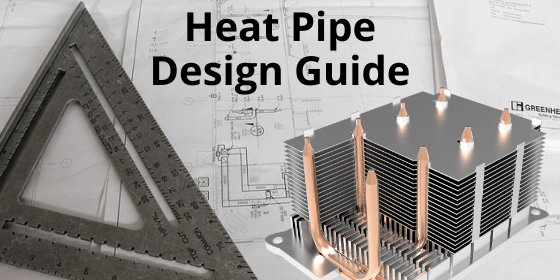Thermosiphon
This page explores the similarities, differences, and best uses of a thermosiphon and a heat pipe.
Similarities Between a Thermosiphon and a Traditional Heat Pipe
The most basic thermosiphon shares the following elements with heat pipes:
- Envelope material made from copper (most common), aluminum, or titanium.
- The use of a working fluid such as water (most common), ammonia, methanol (also used in heat pipes), or some kind of refrigerant.
- An interior that’s been vacuum-sealed to allow the phase change from liquid to vapor at lower temperatures than would occur at atmospheric pressure.
- The ability to have a remote condenser with tubes that can be bent, flattened, and/or plated.
- An evaporator portion of the device where heat is applied, a condenser portion that attaches to a fin stack where the vapor is cooled, and an in-between section called the adiabatic region.
- Thermal conductivity 10-100 times that of solid copper.
Both devices essentially operate the same way, as seen in the figure below.

Thermosiphons & Heat Pipes Work the Same Way
When heat is applied to the evaporator portion of the device, some of the liquid turns to vapor and moves to an area of lower pressure, the condenser end. As it passes through the cooling fins, the vapor turns back to liquid. Lastly, the liquid is returned back to the evaporator where the cycle repeats itself.
Differences Between Thermosiphons and Traditional Heat Pipes
Thermosiphons rely on gravity to move liquid back to the evaporator.

Thermosiphon Inner Workings
Because they have no wick structure to produce the capillary pumping action necessary to move the liquid back to the heat source, thermosiphons rely on gravity to do the job. From this perspective, heat pipes should be used anytime the heat sink assembly has the evaporator at the same level or above the condenser. In these situations, heat pipes rely on the wick structure to transport the liquid.
For a given diameter, thermosiphons have a higher Qmax than heat pipes.
The amount of vapor space available to carry a given load is a crucial factor in determining the device Qmax (maximum heat transport capacity in watts)
The sintered wick lining the walls of a heat pipe reduces the available vapor space, a key component to determining a device’s Qmax. This isn’t a problem for heat pipes as it’s the capillary limit that determines its ability to transport heat. The chart below shows Qmax for various heat pipe sizes where the evaporator is directly below the condenser (+90 degree orientation).
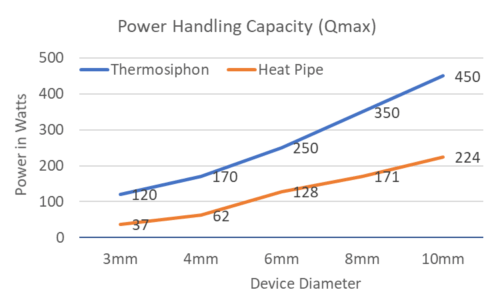
Power Handling Capacity of Thermosiphon vs Heat Pipe
Wickless thermosiphons of the same diameter as heat pipes have 100-200% higher Qmax than the heat pipe counterparts, all because of the additional vapor space. For additional information see this online heat pipe performance calculator.
Thermosiphons can carry heat farther distances than heat pipes
The simple reason thermosiphons operate more effectively over long distances has to do with the ease with which liquid can travel from the condenser to the evaporator. With a heat pipe, the water is transported through the wick structure which is usually porous sintered metal. In a thermosiphon, water easily flows back to the evaporator along the smooth or grooved inner walls.
While a heat pipe’s practical heat transport limit is on the order to 1 to 2 meters, a thermosyphon can easily carry heat distances over 10 meters. This usually isn’t an issue with electronics cooling as most applications will use these devices in distances less than a couple of meters, but worth mentioning, nonetheless.
Thermosiphons are susceptible to damage caused by freezing
The fluid level required for a thermosiphon generally covers between 20-80% of the length of the evaporator, assuming the vessel is in a vertical orientation. This is significantly more than traditional heat pipes and can be problematic if water is used in conditions where they are exposed to freezing temperatures. After repeated freeze/thaw cycles, the expansion of water will form bulges in the evaporator section of the devise, eventually fracturing the enclosure wall. For thermosiphon designs using other fluids, freezing is generally not a concern.
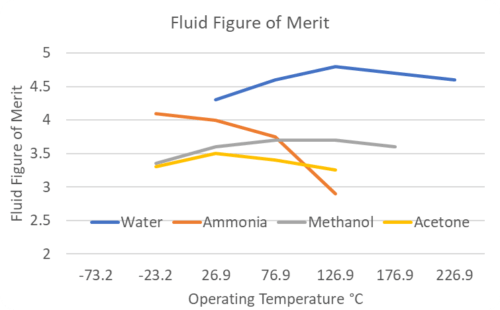
Fluid Figure of Merit
Thermosiphon Variations
There are a couple of variations of this basic design that can improve thermal performance and/or reduce the possibility of structural damage due to freezing.
Thermosiphon with a partial sintered wick structure
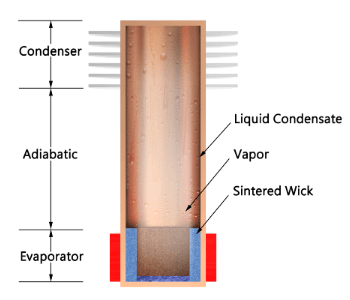
Thermosiphon with a Partial Sintered Wick
Adding a sintered wick to the evaporator section lowers thermal resistance and increases the ability to handle higher power densities. It also allows optimization of the fluid charge, effectively reducing the required liquid. This all but eliminates the possibility of damage caused by freezing. In the bottom portion of the above figure, note that the wick is only used at the evaporator section of the thermosiphon.
Thermosiphon that separates the vapor section from the liquid return section
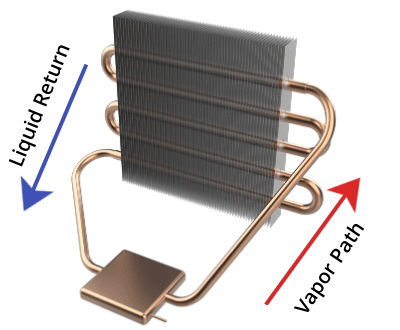
Loop Thermosiphon
Lastly, a loop thermosiphon can be used to separate the vapor flow from the liquid flow, further increasing Qmax. The vapor flow leads directly to the condenser where it cools and returns to liquid which travels back down to the evaporator. In the configuration to the right, the hollow evaporator at the bottom of the device uses a mechanism to prevent vapor from traveling up the liquid flow section but still allowing liquid to enter. The addition of a sintered wick to the evaporator allows less water to be used, decreasing the risk of damage caused by freezing.
Using Thermosiphons to Cool Electronics
Taking into account both the advantages and drawbacks of thermosiphons – when should they be used in electronics environments? Historically the number one use for these are in power electronics applications and recently some use in data centers. Power electronics would include stationary motor controllers in places like steel mills, mining, etc. Also transportation applications such as light rail and subway systems. Recently there has been renewed interest for data center applications as they move towards higher ambient temperatures and a reduced number of fans. Cooling in data centers accounts for about 33% of the operating costs, with cooling fans accounting for almost half that figure.
In summary, thermosiphons are still a relevant technology for cooling high power applications where the evaporator is below the condenser. Applications for thermosiphons include power electronics such as IGBTs as well as radar systems, transmitters, and alternative energy generation.


